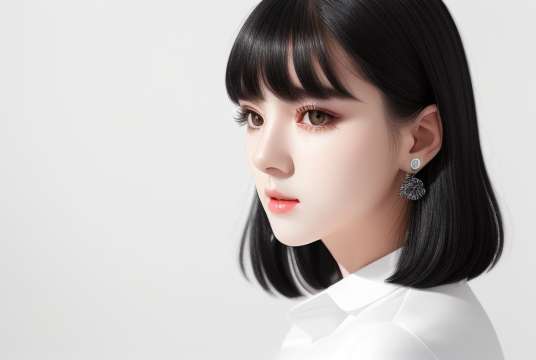Blush has been used since ancient times as a cosmetic for improving the appearance of cheeks and creating a youthful glow. It has gone through centuries of evolution, from crushed beetles and berries to modern-day powders and creams. But have you ever wondered what causes us to blush naturally?
Blushing is a physiological response that occurs when the body releases adrenaline, causing blood vessels in the cheeks to dilate and turn red. This can happen when we're embarrassed or ashamed, but it can also occur when we're aroused or experiencing other intense emotions.
The science of blush goes beyond just the physical reaction, however. Researchers have also studied the psychological effects of blushing on interpersonal relationships and social interactions. Is it a sign of humility and vulnerability, or a sign of lack of confidence and submissiveness? This article delves into the various aspects of blushing, from its biology to its cultural significance.
The History of Blush

Ancient Times
The use of blush can be traced back to ancient civilizations. Egyptians and Greeks used crushed berries and red ochre to create flush on their cheeks. In Ancient Rome, women would use a mixture of chalk and vermilion to enhance their beauty.
16th to 18th century Europe
In Europe, blush was seen as a symbol of social status. Only royalty and nobility were allowed to wear it. During the Renaissance, women would pinch their cheeks and bite their lips to create a flush. In the 18th century, blush became more widely accepted and was worn by women of all social classes.
19th and 20th century
In the 19th century, blush became more refined with the creation of cream and powder formulas. In the early 20th century, Max Factor created the first blush product that was specifically formulated for motion picture use. This product helped to popularize blush as an everyday makeup item.
Blush has continued to evolve with the introduction of new formulas and techniques. Today, it is one of the most popular makeup products and is available in a variety of shades and finishes.
The Ingredients in Blush

Pigments
Blush gets its coloring from a variety of pigments, which can be natural or synthetic. Some of the most common natural pigments in blush include carmine, derived from crushed cochineal beetles, and iron oxides, which create shades of red, pink, and brown. Synthetic pigments are often used to create brighter or more unusual shades.
Binders
Binders are ingredients that give the pigments something to stick to, helping the blush adhere to the skin. Common binders in blush include talc, which creates a soft texture, and silicone, which helps the product stay put.
Emollients
Emollients are moisturizing ingredients that help keep skin feeling soft and smooth. Some blushes contain emollients like jojoba oil, shea butter, or glycerin, which can also help the product blend more easily.
Fragrances
Blushes often contain fragrances to enhance the user's experience. These may be added in the form of essential oils or synthetic fragrances. However, some people may be sensitive or allergic to these ingredients.
Preservatives
Preservatives are used to prevent bacteria and other microorganisms from growing in the blush. Some common preservatives in blush include phenoxyethanol and parabens. However, some people may choose to avoid blushes with certain types of preservatives due to concerns about their safety.
The Benefits of Blush

Enhances Facial Features
One of the benefits of wearing blush is that it can enhance your facial features.Blush helps to add depth to your cheekbones, making them look more prominent and defined. This can help to give your face a more structured and attractive look.
Boosts Confidence
Wearing blush can also help to boost your confidence. By adding a healthy flush to your cheeks, blush can make you feel more vibrant and alive. It can help to give you a more youthful and energetic appearance, which can help you feel more confident in your own skin.
Create a Natural Look
Another benefit of wearing blush is that it can help you create a natural look. Wearing too much makeup can make you look overdone, but a little bit of blush can help to add color to your face in a subtle and natural way. This can help you achieve a more natural and effortless look that is perfect for everyday wear.
Adds Color to the Face
Finally, one of the most obvious benefits of wearing blush is that it can add color to your face. Blush comes in a variety of shades, from soft pinks to bold oranges, and can help to give your face a pop of color that can help you look healthy and vibrant. By choosing the right shade for your skin tone, you can achieve a natural and flattering look that will brighten up your face.
The Right Shade for Your Skin Tone

Fair Skin
If you have fair skin, it is best to choose shades with a hint of pink or peach. Lighter shades of pink will work well and avoid anything too dark or bold. A light pink or soft peach will give a natural and subtle look.
Medium Skin
If you have medium skin, shades with warm undertones are ideal. Choose blushes with golden or bronze hues to complement the warmth in your skin. Avoid blushes with cool undertones, as they can make your skin look too icy.
Dark Skin
For dark skin, bold shades work best. Rich and vividly pigmented hues such as deep plum, red or berry tones will give a pop of color. Avoid anything too light or pastel, as it will not show up on your skin tone.
- If you are unsure which shade of blush to choose, go for a universal color such as a soft rose.
- Always try to test the blush beforehand and check if it suits your skin tone, apply it to your cheeks and make sure it blends well.
- Remember, blush can be layered for a more intense look, so start with a light application and gradually build it up if necessary.
Tips and Tricks for Applying Blush
1. Choose the Right Shade for Your Skin Tone
When choosing a blush, it's important to select a shade that complements your skin tone. Generally, those with fair skin look best in soft pink or peach hues, while those with medium to dark skin tones can opt for deeper shades of pink and coral.
2. Use the Right Brush
Using the right brush can make all the difference when it comes to applying blush. A fluffy, angled brush is ideal for adding a natural-looking flush to the cheeks. Make sure the brush is clean and free from any excess product before applying.
3. Apply Blush to the Apples of Your Cheeks
To achieve a youthful, rosy glow, apply blush to the apples of your cheeks. Use a light hand and blend the product out towards your hairline for a more seamless look. Remember, less is often more when it comes to blush.
4. Customize Your Blush Placement
Everyone's face shape is different, so it's important to customize your blush placement based on your individual features. Those with round faces may want to apply blush slightly higher on the cheekbones, while those with more angular features can apply it more towards the center of the cheeks.
5. Layer Your Products for Longer-Lasting Color
If you want your blush to last all day, layering is key. Start with a cream blush, using your fingers to blend it onto the cheeks. Then, dust a powder blush over the top for extra staying power. This technique will give you a beautiful, long-lasting flush.









